Water Birds
Wherever there is water in arid country there will be concentrations of birds; often these will include some true waterbirds, seemingly quite out of place in the desert.
Grebes are swimmers that are more graceful underwater than in the air, but a few species do migrate across the desert. One, the pied-billed grebe, may show up on any small pond. A pair of pied-billeds may remain to raise young if they find enough plant material with which to build their floating nest. Just as widespread are various members of the heron family. Our largest species, the great blue heron, is sometimes seen flapping slowly over the desert, miles from water. It hunts in typical heron fashion—standing by the water’s edge to spear or seize fish, frogs, and other aquatic creatures—but in a pinch it can also dine on rodents in dry fields.
Ducks are the most conspicuous water birds to reach the desert. Some lakes here may host hundreds of ducks in winter, representing up to a dozen species. Only a few of these will remain to nest in this region. While most ducks arrive here from the north, Whistling-Ducks come from the south. These odd, gangly birds— perhaps related more closely to geese than to true ducks—are typical of the tropics. Black-bellied whistling-ducks have increased here in recent decades, and pairs can be seen attending flotillas of downy ducklings on southern Arizona ponds.
—Kenn KaufmanPied-billed Grebe (Podilymbus podiceps)
Order: Podicipediformes
Family: Podicipedidae (Grebes)
Spanish names: buzo
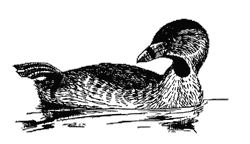
Distinguishing Features
This 12 to 15 inch, drab brown, stocky bird can be distinguished by its short, blunt bill that is encircled with a black band in summer. Its feet are set far back on body which makes travel on land awkward, but is ideal for underwater swimming. The Pied-billed Grebe is seldom seen flying.
Habitat
Frequents ponds, lakes, and marshy areas
Feeding
• Diet: Feeds on a wide variety of aquatic life including insects, spiders, tadpoles and small fish.
• Behavior: Forages by swimming underwater, propelled by its feet.
Life History
This bird lays 4 to 7 eggs in a floating nest that is built by both sexes. Incubation, which is performed by both parents, takes about 23 days. The young are fed by both parents and are able to swim shortly after hatching. Pied-billed Grebes are solitary birds; often only one mating pair is found on a pond or lake.
The Pied-billed Grebe has the odd habit of eating its own feathers, as well as feeding feathers to its young. It also has an interesting behavior when apprehensive or nervous: it expells air from its lungs and feathers, which causes it to slowly sink in the water; it then swims with only its head breaking the water surface.
Great Blue Heron (Ardea herodias)
Order: Ciconiiformes
Family: Ardeidae (Herons, Bitterns)
Spanish names: garza
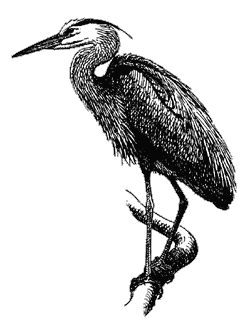
Distinguishing Features
This 42 to 52 inch bird is the largest heron in North America. It has blue-gray wings and back, whitish underparts, and a white head with a black streak. It flies with steady, slow wingbeats; its long legs hang straight back and its long neck is tucked back on its shoulders during flight.
Habitat
This highly adaptable bird can be found in a variety of riparian habitats including desert rivers, ponds, and marshes.
Feeding
• Diet: Mostly fish but also amphibians, reptiles, insects, rodents, and birds.
• Behavior: The Great Blue Heron most often feeds while standing still or slowly wading in shallow water; it strikes at small fish swimming by with its spear-like bill. It is not uncommon for a heron to make a 20 or even 30 mile round trip in its quest for a good foraging site.
Life History
Great Blue Herons breed in colonies. The male chooses the nest site and displays to attract a female. The nest site is typically in a tree 20 to 60 feet above the ground or water, although shrubs are also used as nest sites. The female lays 3 to 5 eggs in a platform nest made of sticks. The eggs, which are incubated by both parents, hatch in 25 to 30 days. The young are fed regurgitated matter by both parents. Young are able to fly after about two months.
Herons are sometimes mistakenly called “cranes.”Other than both having long legs and long necks, they are very different. Cranes are omnivores, often feeding on grain in dry fields, and although cranes may gather in huge flocks during migration and winter, they typically nest as isolated pairs, unlike the colonial Herons.
Ducks
Representative Sonoran Desert species:
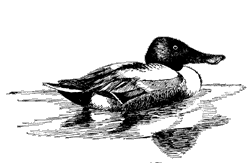 |
Black-bellied Whistling-Duck (Dendrocygna autumnalis)
Green-winged Teal (Anas crecca)
Cinnamon Teal (Anas cyanoptera)
Northern Shoveler (Anas clypeata)
Northern Pintail (Anas acuta)
Redhead (Aythya americana)
Ruddy Duck (Oxyura jamaicensis)
Order: Anseriformes
Family: Anatidae (Ducks, Geese, Swans)
Spanish names: pato (duck); cerceta aliverde (Green-winged Teal);
tilito café (Cinnamon Teal); pichichí (Whistling-Duck);
pato cabeza roja (Redhead)
Distinguishing Features
Black-bellied Whistling-Duck: Reddish brown with a black belly, white wing patches, and a pink bill. This beautifully marked, long-legged, long-necked duck is both sociable and noisy.
Green-winged Teal: Very small; metallic green speculum (a patch on the secondaries). Male: gray body; chestnut head with green eye patch; vertical white mark in front of wing. Female: mottled brown.
Cinnamon Teal: Male is deep rufous, female is a mottled brown. Both have a bluish wing patch.
Northern Shoveler: Often mistaken for a mallard but can be distinguished by its large, dark, shovel-shaped bill, short neck, and pale blue wing patch. Breeding male has green head, white breast, chestnut belly and flanks, white area just before the tail. Females, juveniles, and molting males are drab and mottled.
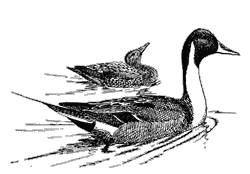 |
Northern Pintail male: slim, gray-colored body; long neck with white throat markings; brown head; long pointed tail. Female: mottled brown with a somewhat pointed tail.
Redhead male: large, round, chestnut-red head; gray body; black breast; blue bill with dark tip. Female: pale bill with dark tip, brown back and sides.
Ruddy Duck: Males are easily recognized from spring until late-summer by their chestnut- colored body, sky-blue bill, black cap, and white face. Females and winter males are gray-bodied, and females have a dark stripe bisecting the white cheek patch. The tail feathers of the Ruddy Duck are often cocked up in the air. This species takes flight only reluctantly, often skittering across the surface of the water to gain speed for takeoff.
Habitat
These waterfowl frequent ponds, marshes, and lakes.
Feeding
• Diet: Whistling-Duck: Mostly seeds and grains. Shoveler and Teal: Seeds and aquatic plants. Redhead: Mostly insects and aquatic plants. Pintail and Ruddy Duck: Mainly seeds and insects.
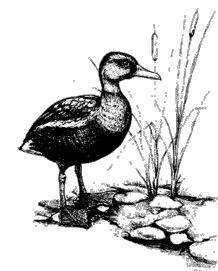 |
• Behavior: Flocks of Black-bellied Whistling-Duck often feed on waste grain in harvested fields, as well as seeds in grasslands and overgrown pastures; insects and other invertebrates make up a small part of their diet.
Teal forage along the edge of ponds dabbling for seeds and other plant matter that are within a neck’s-reach of the surface. The pre-cocial ducklings feed on small aquatic invertebrates and vegetation.
Northern Shoveler feeds in shallow open water where large bill and comblike “teeth” are used to strain out plant and animal matter; diet varies with season; in winter diet consists mostly of aquatic plants; seldom upends or dives.
Northern Pintail are wary birds that prefer to forage in shallow water where they upend or submerge the head and neck while swimming. Some foraging is also done on land.
Redheads forage by diving or upending, usually in shallow water. Ninety percent of their food is vegetable matter, but they will feed on snails, mollusks, and insects.
Ruddy Ducks forage by diving and swimming under water where their broad bill collects and strains food from mud.
Life History
Except for the Whistling-Ducks and Mallards, few ducks spend the summer breeding season in the Sonoran Desert region. Most nest in the “prairie pothole region” of southern Canada and north central United States, or around lakes in the forest or tundra regions of Canada and Alaska. However, more than 20 species of ducks can be found wintering regularly in the Sonoran Desert region.
Comments
Black-bellied Whistling-Duck: United States populations are increasing, probably because of nest boxes. This species was rare in Arizona before 1949 but has since become a rather common nesting bird.
Northern Pintail: Although this species is widespread and abundant, there is some indication that numbers have been declining during the last 40 years. Drought may be responsible for dramatic reductions in nesting success.
Redhead: It appears that this species has suffered more severe population declines than most other ducks. This may be due to loss of nesting habitat.